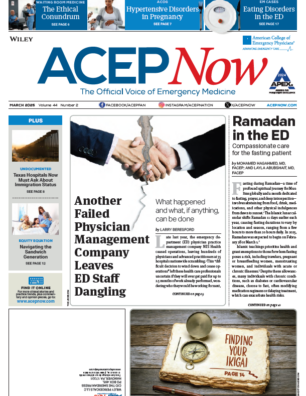Slide the probe proximally until the rounded radial head and the lateral epicondyle are visualized (Pic 3).
Explore This Issue
ACEP News: Vol 32 – No 09 – September 2013The capitellum is the articular surface of the distal humerus and articulates with the radial head. Superficial to the radio-capitellar joint space is the common extensor tendon, which can be easily identified and avoided with ultrasound. An effusion of the joint capsule will appear as a hypoechoic/anechoic fluid collection that displaces the fat pad superficially (Pic 4).
Ultrasound-Guided Elbow Arthrocentesis (Lateral Approach)
Materials (Pic 1B)*:
- Sterile ultrasound sheath and gel
- 30g tuberculin syringe filled with 1-2% lidocaine
- Chlorhexidine scrub
- Sterile drape
- Sterile gloves
- 18g 1.5 needle attached to a 5-10 cc syringe
Pic. 5A: Place the ultrasound screen contralateral to the elbow, allowing for direct visualization of both the ultrasound image as well as the location of the joint capsule aspiration. 5B: Using M-mode can be a simple way to ensure that the center of the probe correlates with the center of the screen.
*Pictures are for educational purposes, and sterile precautions (sterile probe cover, gloves, drapes, etc.) should be used for all joint aspirations.
Arthrocentesis is a sterile procedure, and the patient should be draped and prepped in the standard manner. Place the ultrasound probe in a sterile sheath and position the ultrasound machine opposite the provider so that the screen is in direct line of sight (Pic 5A).
We recommend placing towels or sheets under the elbow to elevate the joint and make the procedure easier to perform. Locate the lateral radio-capitellar joint space and ensure the center of the probe is located at the middle of the effusion.
Pic. 6A and 6B: Place a small amount of local anesthetic just under (anatomically medial to) the probe.
Using the M-mode line is a simple trick that can be used to ensure that the probe image on the screen is in the middle of the probe (Pic 5B). Inject a small amount of local anesthetic for patient comfort just medial (just below) the center of the transducer (Pic 6).
Using a 5-10cc syringe attached to standard 18g needle, enter the skin at the midpoint of the probe at a steep angle (80-90 degrees), out-of-plane to the ultrasound probe (Pic 7).
The clinician performing the arthrocentesis should be aware of the depth of the joint capsule effusion during the procedure, as well as actively aspirating the syringe as the needle advances.
Pages: 1 2 3 | Single Page





No Responses to “Ultrasound-Guided Elbow Arthrocentesis”